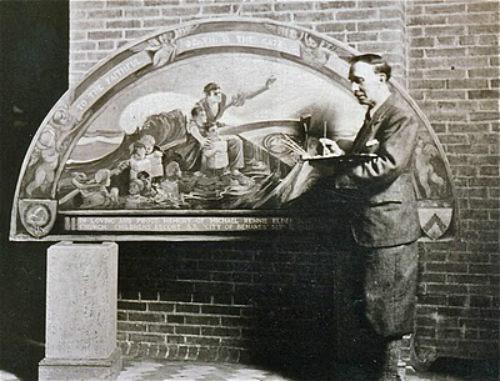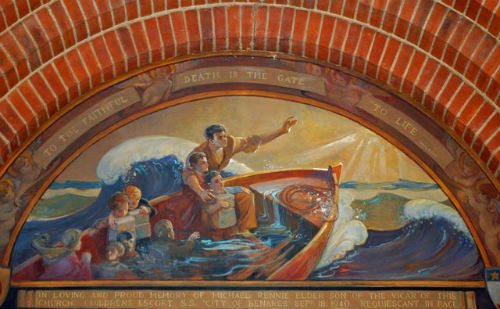75 years since sinking of 'Children's Ship' City of Benares


Mural showing Michael Rennie, children's escort, in the lifeboat with children from the City of Benares. Copyright The Parish Church of St Jude-on-the-Hill, Hampstead Garden Suburb.
2015 marked the 75th anniversary of the loss of the City of Benares, torpedoed and sunk by a German U-boat in the North Atlantic during the Second World War. What makes her loss stand out amongst the many lost merchant ships however is the 90 children she was carrying. They were travelling under the government’s CORB (Children’s Overseas Reception Board) scheme to evacuate children away from a Britain facing the Blitz, and the ever growing possibility of invasion, to the safer shores of the Dominions, particularly Canada, South Africa, Australia and New Zealand.
The children on the City of Benares were accompanied by a group of escorts, all of whom had volunteered to undertake the dangerous wartime crossing and take responsibility for the children’s welfare until they could be safely delivered to waiting foster families in Canada. The Benares had been at sea for 5 days and was believed to have passed beyond the range of U-Boat activity when she was hit at 10.03pm on 17 September 1940. Believing the danger zone to be behind them, the children had undressed for bed for the first time that night and their naval escort had departed earlier in the day. The ship sank fast, about thirty minutes after impact, and the crew struggled to safely launch the lifeboats in the middle of an Atlantic storm at night. Even those fortunate enough to find themselves in a lifeboat found their boats almost completely waterlogged. The lifeboats’ floatation devices allowed them to remain afloat even after flooding, but this left their occupants sat in icy water and in danger of floating out of the boat altogether.
Rescue did not arrive until the following afternoon, in the form of Royal Navy Destroyer HMS Hurricane. Sadly, after hours in dreadful conditions, the Destroyer found many of the survivors of the attack had subsequently perished from exposure. Hardest hit were the evacuee children, of whom the eventual death toll was 77 of the 90 on board. There was universal praise afterwards for all of the children’s escorts, they had devoted themselves to the children’s care during the voyage and continued to do so after the torpedo hit. One of these escorts was 23 year old Theology student, Michael Rennie. A keen sportsman, newly graduated from Keble College Oxford, and hoping to follow his father into the Church, Rennie was extremely popular with the children. A surviving child recalled that after the sinking:
“…he dived in again and again to rescue them [the children]…the other men warned him repeatedly not to do so as he would get exhausted; but he said ‘There are still children in the water, and I must get them’”
Sadly his heroic efforts took their toll and eventually he succumbed to exhaustion and exposure. Just two of the children in his lifeboat survived, but in many other boats none survived at all. In my research for our online exhibition, I came across a reference to a memorial to Rennie in the London church where his father was Vicar. I was planning a trip to London anyway and, realising the church was in Golders Green not far out of my way, I decided I would go and see the memorial for myself. I had assumed at first that it would be a traditional plaque, perhaps in bronze or marble. It was only upon contacting the church and looking at some information on their website that I realised it was actually a mural depicting Rennie in the lifeboat after the sinking. What I did not realise until I arrived however was that the whole interior of the church, walls and ceilings, were covered in these beautiful murals. It was absolutely stunning, and would have been worth the visit simply to see this magnificent artwork.

Starmer at work on the mural. You can see in this photo that the mural was actually painted on canvas and then fitted into a recess in the wall rather than being painted onto the walls directly as all the other at the church were. Copyright The Parish Church of St Jude-on-the-Hill, Hampstead Garden Suburb'
The murals, including the memorial to Rennie, were painted by Walter Percival Starmer who originally worked on the church between 1919 and 1929 and afterwards continued to attend the church for a further 15 years. What is particularly significant about these dates is that during this time he would have watched a young Michael Rennie grow up, giving the memorial an appropriately personal and poignant edge. The church’s current Vicar, Alan Walker, who met with me to show me around, was kind enough to contact me afterwards and send some scans of letters held in the church archive. The letters are between Michael’s father, William Maxwell Rennie, and a young boy called Louis Walder, one of the two children to survive from Michael Rennie’s lifeboat. Louis’ letter includes the account from which the above quote is taken, detailing Rennie’s disregard for his own safety in his efforts to save the children. The letters from Rennie’s father are gracious and restrained but there is a note of desperation in them that struck me, a longing for any tiny piece of information about his son’s last hours, that reveals a deeply grieving father.
“My Dear Louis, First of I must congratulate you on coming safely through your dreadful experience of being torpedoed. It was my son, Michael Rennie, who was one of the escorts who died; and I believe he was actually in the lifeboat in which you were. I should be very grateful to you if you could let me know anything about my son…”
His concern and well-wishes throughout the letters for Louis and his sister (who was also a fortunate survivor of the sinking), his gratitude to Louis for any small piece of information about his son, and his kind invitation to them to come and visit him at the vicarage and view the memorial, all make for deeply moving reading. Rennie was only 8 years older than the eldest of the evacuees and had a bright and promising future ahead of him.
In researching this tragedy, I found many stories like his that bring home the human element of loss behind the numbers; 258 lost, including 77 evacuee children, whose parents had sent them away in hope of preserving their safety, and 6 of the 10 adults who had volunteered to escort them. After the loss of the Benares no more children were sent overseas under the CORB scheme. Several thousand had already been sent however and safely reached Canada, Australia, New Zealand and South Africa. By the end of 1940 the war at sea meant that the risk of another tragedy was simply too high to continue such a desperate scheme.
Today it may seem a terrible risk to have undertaken but having watched Germany sweep across Western Europe, even getting as close the Channel Islands (the only part of the British Isles that would fall under German occupation during the war), the threat of invasion was very real. The adults involved, escorts and parents alike, were making what must have been a heart-rendingly difficult decision in an attempt to keep these children safe. Sadly in the sinking of the Benares the worst of the schemes risks were realised.
Eleven of the children on board the City of Benares were from Sunderland, with only two of them surviving. On 3 October 2015 there was a memorial service to mark the 75th anniversary of the disaster, organised by the Sunderland Volunteer Life Brigade, at 11am in All Saints Church, Fulwell Road, Sunderland. The Brigade also put together a small exhibition to mark the anniversary, see here for details.
